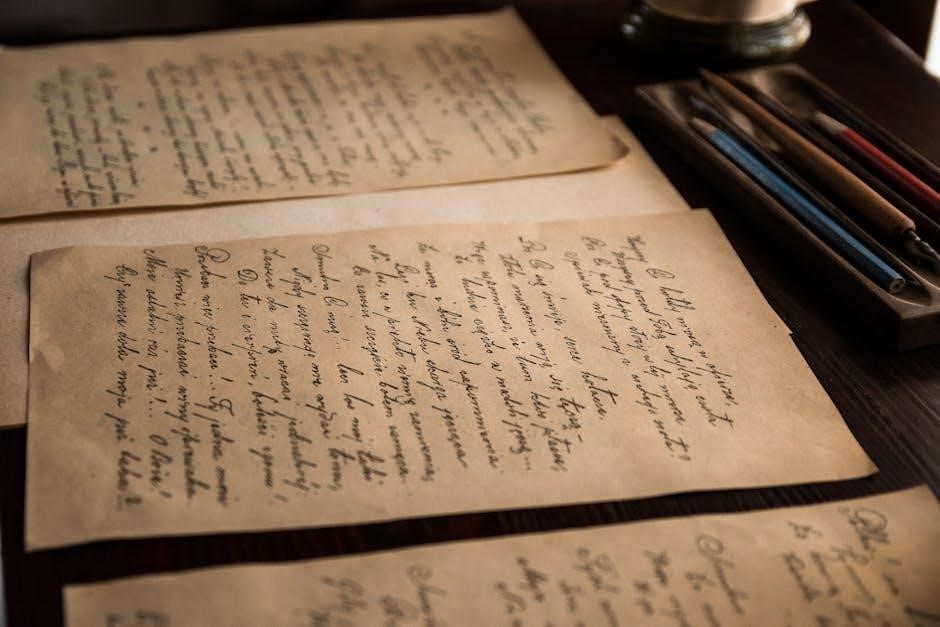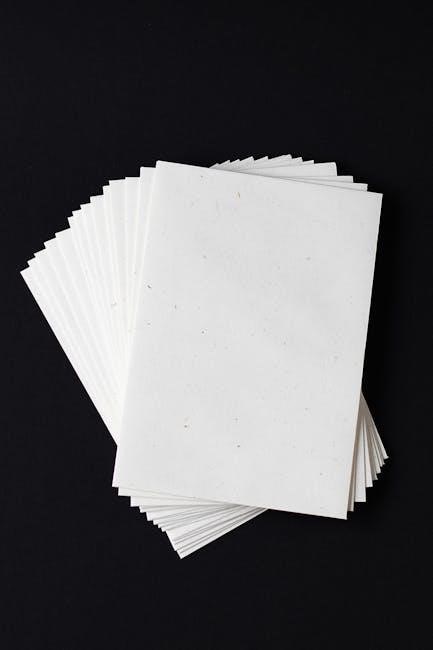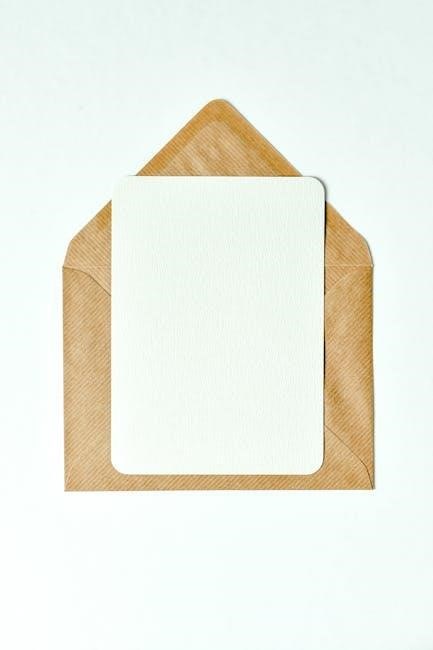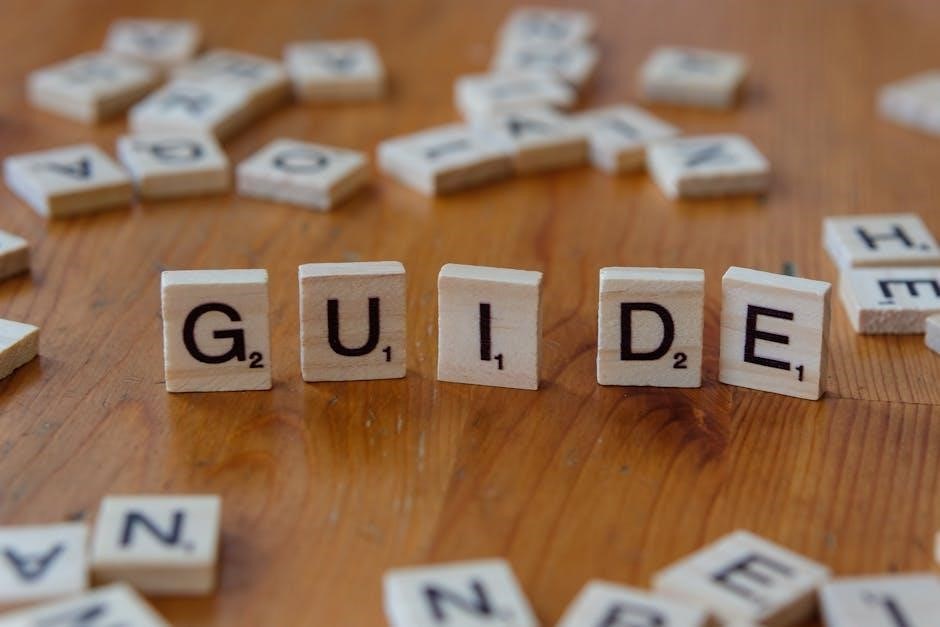The Ames Lettering Guide is a precise tool for drafting and calligraphy, offering adjustable line spacing and alignment. Used by professionals and designers since 1917.
1.1 What is the Ames Lettering Guide?
The Ames Lettering Guide is a precision mechanical device designed to assist in creating consistent and accurate lettering, spacing, and alignments in drafting and lettering tasks. It is commonly used by architects, engineers, and graphic designers to produce professional-quality text and annotations. The tool typically features an adjustable mechanism that allows users to set specific letter heights and spacing, ensuring uniformity across documents. Its compact design makes it portable and easy to integrate into various workflows. The Ames Lettering Guide is particularly valued for its ability to maintain precision, even in complex layouts, making it an essential instrument for anyone requiring high standards of lettering accuracy.
1.2 Importance in Lettering and Drafting
The Ames Lettering Guide is a vital tool in lettering and drafting, ensuring precision, consistency, and professionalism in text creation. It is widely used by architects, engineers, and designers to produce uniform lettering and spacing, which is critical for maintaining readability and aesthetic appeal in technical documents. The guide minimizes errors and saves time by providing a reliable method for aligning and sizing letters. Its importance lies in its ability to enhance the clarity and professionalism of drawings, making it indispensable in industries where precise communication is essential. By standardizing lettering, the Ames Lettering Guide contributes to the overall quality and effectiveness of technical documentation, ensuring that ideas are conveyed accurately and efficiently.

History and Evolution of the Ames Lettering Guide
The Ames Lettering Guide was invented in the early 20th century by Frank Ames, revolutionizing lettering precision. Over decades, it evolved with improved materials and designs, remaining indispensable in drafting and lettering.
2.1 Invention and Development
The Ames Lettering Guide was invented by Frank Ames in the early 20th century, revolutionizing lettering in technical drawing. Patented in 1915, it aimed to simplify lettering processes and ensure uniformity. Ames, a skilled draftsman, identified the need for a tool that could produce precise, consistent lettering quickly. His innovative design featured adjustable slots and a sliding mechanism, allowing users to align letters accurately. The guide initially gained popularity among architects, engineers, and cartographers, becoming an essential tool in drafting. Over time, its design evolved to accommodate various lettering styles and scales, solidifying its place as a cornerstone in professional drafting kits. The Ames Lettering Guide remains a testament to Ames’ ingenuity and his contribution to the field of technical drawing.
2;2 Impact Over the Years
The Ames Lettering Guide had a profound impact on drafting and lettering, becoming an indispensable tool for professionals. Its introduction in the early 20th century revolutionized technical drawing by enabling precise, uniform lettering. Architects, engineers, and cartographers widely adopted it, as it enhanced the clarity and professionalism of their work. The guide’s ability to maintain consistency across large-scale projects made it a standard in the industry. Over the decades, it remained a trusted companion for draftsmen, even as technology advanced. Its influence extended to educational institutions, training generations of professionals in precise lettering techniques. Despite the rise of digital tools, the Ames Lettering Guide retains its legacy as a cornerstone of traditional drafting, symbolizing the importance of precision and craftsmanship in technical communication.

Design and Features of the Ames Lettering Guide
The Ames Lettering Guide features an adjustable mechanism and multiple scales, allowing precise lettering and spacing; Its durable design ensures accuracy and uniformity in technical drafting and lettering.
3.1 Adjustable Mechanism
The Ames Lettering Guide is renowned for its adjustable mechanism, which allows users to customize letter spacing and alignment effortlessly. This feature is integral to the tool’s functionality, enabling precise control over lettering styles. The mechanism typically consists of sliding parts or adjustable screws that can be calibrated to achieve uniformity in text layout. Its versatility makes it suitable for various font sizes and formats, ensuring consistency in both technical drafting and artistic lettering. The adjustable mechanism is particularly valued for its ease of use, catering to both professionals seeking accuracy and beginners learning to master lettering techniques. This feature underscores the tool’s adaptability, making it a indispensable asset for anyone requiring precise and professional-grade lettering outcomes.
3.2 Scales and Measurements
The Ames Lettering Guide incorporates precise scales and measurements to facilitate accurate lettering and drafting. These scales are carefully calibrated to ensure uniformity in letter spacing, height, and alignment. The tool often features multiple measurement markers catering to various font sizes and styles, allowing users to maintain consistency across different projects. The integration of these scales enables quick adjustments and precise alignment, which is crucial for both technical and artistic applications. By providing clear visual guides, the Ames Lettering Guide simplifies the process of creating professional-grade lettering, making it an essential tool for drafters, designers, and artists who value precision and consistency in their work;

How to Use the Ames Lettering Guide
Align the guide with your writing surface, set the desired letter height, and use the built-in scales to draw consistent guidelines for precise lettering.
4.1 Basic Techniques
Start by aligning the Ames Lettering Guide with your writing surface. Set the letter height using the adjustable mechanism. Use the built-in scales to draw consistent horizontal or vertical guidelines. Hold the guide firmly and use a pencil or marker to create evenly spaced letters. For straight lines, align the guide’s edge with your paper. Practice letter formation by tracing the guide’s slots. Begin with simple fonts like block letters before moving to scripts. Always ensure the guide is clean and properly calibrated for accuracy. This method ensures uniformity and precision, making it ideal for both drafting and artistic applications. Regular practice will enhance your skills in using the guide effectively.
4.2 Advanced Tips
For advanced users, experiment with combining multiple scales to create intricate layouts. Use the adjustable mechanism to precision-align letters for complex designs. Practice layering guidelines to achieve multi-line text with perfect spacing. To enhance readability, vary letter heights and spacing for visual hierarchy. For decorative effects, incorporate slanted or curved lines using the guide’s edge. Mastering these techniques requires patience and practice. Additionally, explore integrating the guide with stencils or digital tools for hybrid workflows. Advanced users can also customize their approach by developing personal lettering styles while maintaining the guide’s precision. This versatility makes the Ames Lettering Guide invaluable for professionals seeking artistic flair in their work. Continuous experimentation will unlock its full creative potential.

Benefits of the Ames Lettering Guide
The Ames Lettering Guide offers precision, consistency, and versatility, making it ideal for both professionals and novices. It streamlines workflows, enhances creativity, and ensures high-quality results consistently.
5.1 For Professionals

The Ames Lettering Guide is a game-changer for professionals, offering unmatched precision and consistency in lettering. Its adjustable mechanism ensures uniformity in spacing and alignment, which is critical for high-quality drafting and design work. Professionals benefit from its durability and ability to withstand heavy use, making it a long-lasting tool in their workflows. The guide’s versatility allows it to be used across various materials and projects, from architectural plans to artistic designs. By streamlining the lettering process, it saves time and reduces errors, enabling professionals to focus on creativity and detail. Its timeless design and reliability make it an indispensable asset for anyone requiring precise and professional-grade lettering outcomes.
5.2 For Beginners
The Ames Lettering Guide is an excellent tool for newcomers to lettering and drafting, offering simplicity and ease of use. Its intuitive design helps beginners master consistent lettering techniques without prior experience. The guide’s clear markings and adjustable features allow users to practice precise spacing and alignment, essential for developing good habits early on; It supports the learning process by enabling the creation of uniform letters and lines, which is crucial for building confidence. Additionally, its durability ensures it can withstand the wear and tear of frequent use, making it a reliable companion for those just starting out. The Ames Lettering Guide is a valuable resource for beginners, providing the foundational skills needed to progress in lettering and drafting.

Maintenance and Care
Regularly clean the Ames Lettering Guide with a soft cloth and store it in a dry place to prevent rust or damage. Always check for wear and tear to ensure optimal performance over time.
6.1 Cleaning
Cleaning the Ames Lettering Guide is essential to maintain its accuracy and longevity. Use a soft, dry cloth to wipe away dirt, dust, or ink residue from the surface. For more thorough cleaning, dampen the cloth slightly with water, but avoid soaking the tool. Harsh chemicals or abrasive materials should be avoided, as they can damage the finish or harm the metal components. If ink or debris is stubborn, a mild soap solution can be used, but rinse it thoroughly and dry immediately to prevent rust. Regular cleaning ensures the guide remains precise and functional, making it a reliable tool for lettering and drafting tasks. Consistent maintenance also prevents the buildup of grime, which could interfere with its performance over time. Always clean the guide after use to maintain its quality and ensure optimal results.
6.2 Storage
Proper storage of the Ames Lettering Guide is crucial to preserve its condition and ensure longevity. After cleaning, store the guide in a cool, dry place away from direct sunlight and moisture to prevent rust or warping. Use the original protective case or a sturdy pouch to safeguard it from dust and scratches. Avoid storing it in humid environments or extreme temperatures, as this can affect its metal components. For added protection, consider placing it in a drawer or container lined with soft material. Always store the guide flat to prevent bending or misalignment of its adjustable mechanism. Regularly organizing your workspace and tools will also help prevent accidental damage. Proper storage ensures the Ames Lettering Guide remains in excellent condition, ready for precise lettering and drafting tasks. Consistent care enhances its durability and performance over time. Always handle the guide with care during storage to maintain its quality.

Alternatives and Comparisons
The Ames Lettering Guide can be compared to traditional tools like French curves and lettering stencils. Digital alternatives include design software, offering more versatility and ease of use for precise lettering.
7.1 Traditional Tools
Traditional tools like French curves, lettering stencils, and ruling pens have long been used for precise lettering and drafting. French curves are ideal for creating smooth, curved lines, while lettering stencils offer uniformity in font styles. Ruling pens and straightedges are also popular for manual lettering, providing crisp lines and accuracy. However, these tools often require more time and skill to use effectively compared to the Ames Lettering Guide. While they are still valued for their precision, they lack the versatility and ease of adjustment that the Ames guide offers. For those who prefer a more hands-on, traditional approach, these tools remain reliable alternatives, especially in situations where modern aids are unavailable. They emphasize the craftsmanship and artistry of manual lettering, making them a cherished choice for many professionals and enthusiasts alike.
7.2 Digital Tools
In the modern era, digital tools have revolutionized lettering and drafting, offering unparalleled convenience and precision. Software like Adobe Illustrator and CorelDRAW enables users to create intricate lettering with ease, utilizing vector graphics and typography tools. CAD (Computer-Aided Design) programs further enhance this by providing technical accuracy for drafting. Online font generators and typography apps allow instant customization, catering to diverse design needs. Additionally, touchscreen drawing tablets, such as Wacom or iPad Pro, enable artists to craft lettering with digital brushes, mimicking traditional techniques. Mobile apps like Procreate and Affinity Designer provide portable solutions for lettering on the go. These tools are faster and more versatile than the Ames guide, offering unlimited design possibilities. However, they require a different skill set and may lack the tactile experience many designers prefer. Despite this, digital tools continue to dominate contemporary lettering and drafting workflows.

The Future of Lettering Guides
The future of lettering guides lies in blending traditional craftsmanship with modern technology, ensuring tools like the Ames guide remain relevant in evolving design landscapes.
8.1 Blending Traditional and Digital

The integration of traditional lettering techniques with digital tools is revolutionizing the Ames Lettering Guide’s functionality. By incorporating software compatibility, users can now transfer precise hand-drawn lettering directly to digital platforms, enhancing accuracy and efficiency. This hybrid approach allows professionals to maintain the artistic integrity of traditional methods while leveraging modern technology for scalability and collaboration. The Ames guide’s adaptability ensures it remains indispensable in both analog and digital workflows, catering to the evolving needs of designers and drafters. This seamless blend not only preserves the timeless craftsmanship of lettering but also embraces innovation, making it a versatile tool for future generations.
8.2 Innovations in Lettering Technology
Recent advancements in lettering technology have introduced innovative features to the Ames Lettering Guide, enhancing its precision and versatility. Modern versions now incorporate laser-engraved scales for greater accuracy and durability. Additionally, some models feature adjustable tension controls, allowing users to customize the tool’s responsiveness. The integration of smart technology, such as digital alignment sensors, enables real-time feedback, ensuring perfectly straight lines and consistent letter spacing. Furthermore, eco-friendly materials are being explored to make the guide more sustainable. These innovations not only preserve the tool’s traditional appeal but also cater to contemporary demands for efficiency and environmental consciousness. Such updates ensure the Ames Lettering Guide remains a cutting-edge instrument in the ever-evolving field of lettering and drafting.
The Ames Lettering Guide remains a cornerstone of precise lettering, blending traditional craftsmanship with modern innovation. Its versatility and enduring appeal ensure its continued relevance in both analog and digital eras.
9.1 Summary
The Ames Lettering Guide is a timeless tool that has revolutionized lettering and drafting with its precision and versatility. Invented to address the need for consistent lettering, it has become indispensable for professionals and beginners alike. Its adjustable mechanism and calibrated scales ensure uniformity in lettering, making it a staple in various industries. Over the years, it has evolved, adapting to modern demands while retaining its core functionality. The guide’s ability to maintain accuracy and aesthetics has solidified its place in both traditional and digital workflows. Its enduring relevance underscores the importance of blending craftsmanship with innovation, ensuring its continued use in an ever-changing creative landscape.
9.2 Final Thoughts
The Ames Lettering Guide stands as a testament to innovative design and practicality, leaving an indelible mark on lettering and drafting. Its ability to adapt to modern needs while preserving traditional techniques makes it a cherished tool for both professionals and hobbyists. As technology advances, the guide’s timeless appeal lies in its simplicity and effectiveness, serving as a bridge between analog craftsmanship and digital innovation. For anyone seeking precision and creativity in their work, the Ames Lettering Guide remains an essential companion. Its enduring legacy ensures that the art of lettering will continue to thrive, blending tradition with progress for future generations to appreciate and utilize.

